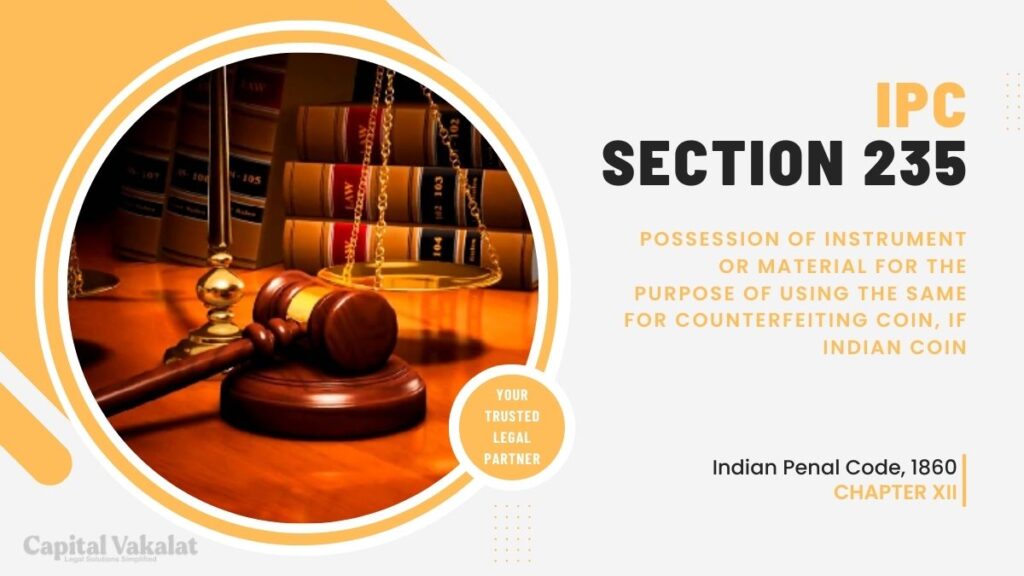Counterfeiting, especially in the context of currency, is a serious crime that can have far-reaching consequences for both individuals and the economy of a nation. Section 235 of the Indian Penal Code (IPC) deals specifically with the possession of instruments or materials with the intent to use them for counterfeiting Indian coins.

In this article, we will explore the various aspects of Section 235 IPC, including its historical significance, legal implications, types of instruments and materials covered, penalties, notable cases, preventive measures, and the role of technology in detecting counterfeiting.
Introduction to Section 235 IPC
Section 235 of the Indian Penal Code is an essential legal provision that addresses the issue of counterfeiting Indian coins. It provides the legal framework for dealing with individuals who possess instruments or materials with the intent to counterfeit Indian coins, thereby safeguarding the integrity of the Indian currency system.
Understanding Possession of Instruments or Materials for Counterfeiting Coins
To comprehend the essence of Section 235 IPC, one must first understand what it means to possess instruments or materials for counterfeiting coins. This involves having items such as dies, moulds, metals, or other materials specifically designed or adapted for the creation of counterfeit coins.
Historical Significance of Counterfeiting Coins
Counterfeiting coins has a long history that predates modern currency systems. Throughout the ages, counterfeiters have sought to exploit the financial systems for personal gain. The impact of counterfeiting on economies and societies has been a driving force behind the enactment of laws like Section 235 IPC.
The Legal Implications of Section 235 IPC
Section 235 IPC outlines the legal consequences of possessing instruments or materials for counterfeiting Indian coins. Those found guilty of such possession can face severe penalties and imprisonment. The law is designed to act as a deterrent, aiming to protect the Indian currency from counterfeit threats.
Types of Instruments and Materials Covered
The instruments and materials covered under Section 235 IPC encompass a wide range of items. This includes machinery, dies, moulds, metals, or any other materials that can be employed to create counterfeit coins. The law’s broad scope ensures that all potential means of counterfeiting are addressed.
Penalties and Punishments for Violating Section 235 IPC
The consequences of violating Section 235 IPC are stringent. Individuals caught in possession of instruments or materials for counterfeiting Indian coins can face imprisonment, fines, or both. The severity of the punishment depends on the circumstances and the specific intent of the individual involved.
Notable Cases of Counterfeiting Coins
Throughout history, there have been several notable cases of coin counterfeiting, some of which have had significant economic repercussions. Examining these cases provides insight into the importance of laws like Section 235 IPC in deterring such activities.
Preventive Measures and Security Features
To combat counterfeiting effectively, governments and financial institutions have adopted various preventive measures and incorporated advanced security features into currency designs. These measures serve as obstacles for counterfeiters and enhance the authenticity of legal tender.
Role of Technology in Detecting Counterfeiting
Advancements in technology have revolutionized the detection and prevention of counterfeiting. From UV markings to digital watermarking, these innovations have made it increasingly difficult for counterfeiters to produce fake currency.
Conclusion
Section 235 IPC plays a crucial role in protecting the integrity of the Indian currency system. By addressing the possession of instruments or materials for counterfeiting coins, it serves as a deterrent against fraudulent activities that can undermine the financial stability of the nation. Through a combination of legal measures, preventive actions, and technological advancements, India continues to combat the ongoing battle against counterfeiting.
Frequently Asked Questions
What are the legal consequences of violating Section 235 IPC?
Individuals caught in possession of instruments or materials for counterfeiting Indian coins can face imprisonment, fines, or both, depending on the circumstances and the specific intent.
What role does technology play in detecting counterfeiting?
Technology has greatly enhanced the detection and prevention of counterfeiting by introducing advanced security features and innovative methods for verifying the authenticity of currency.
Are there any historical cases of coin counterfeiting in India?
Yes, there have been historical cases of coin counterfeiting in India, some of which have had significant economic repercussions.
How can individuals protect themselves from counterfeit currency?
Individuals can protect themselves by being aware of security features in legal tender, using electronic payment methods, and reporting any suspicious currency to authorities.